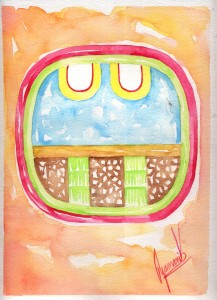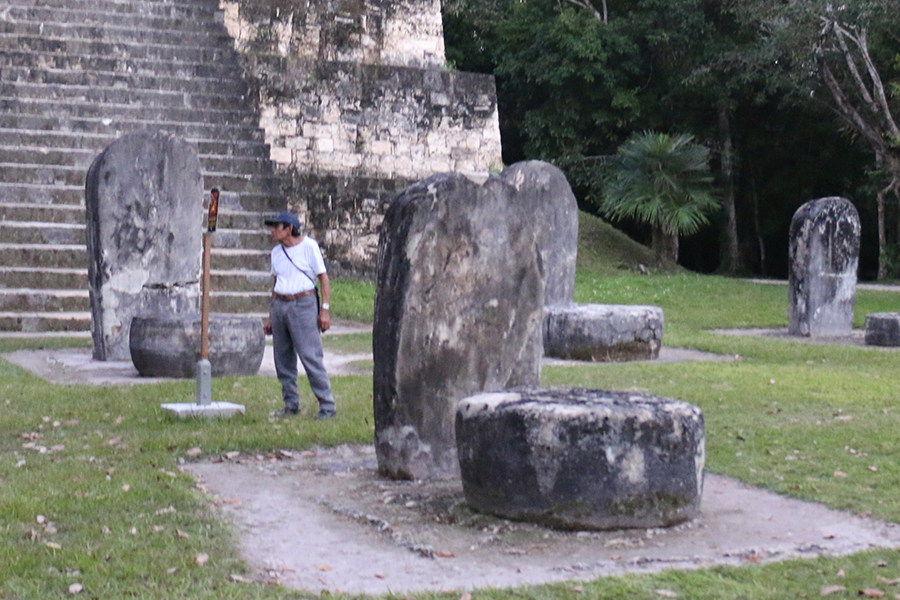 Number 12 has the energy of the group, the family, and the association; Kawoq also presides over matters that concern the family, the community, and society overall. Every one of us has a purpose to fulfill in this life, which is determinant to the evolution of all humanity. Use your knowledge, abilities and experience, no matter what your work or mission is, always know that you are an important part of evolution; that your life and actions are valuable to everyone else.
Number 12 has the energy of the group, the family, and the association; Kawoq also presides over matters that concern the family, the community, and society overall. Every one of us has a purpose to fulfill in this life, which is determinant to the evolution of all humanity. Use your knowledge, abilities and experience, no matter what your work or mission is, always know that you are an important part of evolution; that your life and actions are valuable to everyone else.
11 Tijax – Today’s Maya Day Sign (Ch’umil)
 Tijax represents, the knife, the double-blade obsidian stone, it brings with it the strength and power of the warrior. With the energy of number 11 come many tests and payments, as you are acquiring knowledge through experience, which can sometimes bring complications. Be careful with your words today, for they can become sharp knives that hurt the feelings of those around you.
Tijax represents, the knife, the double-blade obsidian stone, it brings with it the strength and power of the warrior. With the energy of number 11 come many tests and payments, as you are acquiring knowledge through experience, which can sometimes bring complications. Be careful with your words today, for they can become sharp knives that hurt the feelings of those around you.
10 No’j – Today’s Maya Day Sign (Ch’umil)
 No’j is the energy that governs the mind; it symbolizes the intellect, knowledge, wisdom and spiritual learning, it transforms our knowledge into wisdom. Number 10 is the energy of creativity, of flowing. Today is a good day to share your ideas, no person possesses all knowledge, but working together under the guidance of the Creator we can share our knowledge with others and together turn it into wisdom.
No’j is the energy that governs the mind; it symbolizes the intellect, knowledge, wisdom and spiritual learning, it transforms our knowledge into wisdom. Number 10 is the energy of creativity, of flowing. Today is a good day to share your ideas, no person possesses all knowledge, but working together under the guidance of the Creator we can share our knowledge with others and together turn it into wisdom.
9 Ajmaq – Today’s Maya Day Sign (Ch’umil)
 Today the energy of number 9 envelops you in its warm and loving vibrations; it helps you to get in contact with your emotions and act with compassion. The day Ajmaq connects you to a universal vision that merges with your own reality; it is the day in which the great elders and wise men would share their teachings. Call upon the energy of this day so that the words of the wise elders live within you and allow you to be the guide for others.
Today the energy of number 9 envelops you in its warm and loving vibrations; it helps you to get in contact with your emotions and act with compassion. The day Ajmaq connects you to a universal vision that merges with your own reality; it is the day in which the great elders and wise men would share their teachings. Call upon the energy of this day so that the words of the wise elders live within you and allow you to be the guide for others.
8 Tz’ikin – Today’s Maya Day Sign (Ch’umil)
7 I’x – Today’s Maya Day Sign (Ch’umil)
 The female energy will manifest itself today through I’x, which represents the mother, the daughter, the wife and Mother Earth. Number 7 projects faith, spirituality, balance and intuition; it is a force that can harmonize, the power to impel. Use the energies of this day to connect with your feminine power and develop your spirituality and intuition.
The female energy will manifest itself today through I’x, which represents the mother, the daughter, the wife and Mother Earth. Number 7 projects faith, spirituality, balance and intuition; it is a force that can harmonize, the power to impel. Use the energies of this day to connect with your feminine power and develop your spirituality and intuition.
6 Aj – Today’s Maya Day Sign (Ch’umil)
 Number 6 brings many tests that result in learning. Aj represents the columns of inner strength; the spiritual law and divine authority. Disagreements and changes tend to occur under these energies, don’t become discouraged or lose sight of your final destination; these tests will strengthen your inner pillars.
Number 6 brings many tests that result in learning. Aj represents the columns of inner strength; the spiritual law and divine authority. Disagreements and changes tend to occur under these energies, don’t become discouraged or lose sight of your final destination; these tests will strengthen your inner pillars.
5 E – Today’s Maya Day Sign (Ch’umil)
 E is the energy and means by which we will travel our roads in life, it represents the Sacred Road; it sets the conditions of our journey and provides us with the power to accomplish the mission for which we are born. Number 5 is elevation to creation; the energy of action. This day possesses a great positive energy. Today the Saq’ Be’ ―the White Road, the Sacred Road― connects you with the energies of the cosmos through spirituality, love and compassion. This is also a good day to start projects that will improve your economy.
E is the energy and means by which we will travel our roads in life, it represents the Sacred Road; it sets the conditions of our journey and provides us with the power to accomplish the mission for which we are born. Number 5 is elevation to creation; the energy of action. This day possesses a great positive energy. Today the Saq’ Be’ ―the White Road, the Sacred Road― connects you with the energies of the cosmos through spirituality, love and compassion. This is also a good day to start projects that will improve your economy.
4 B’atz’ – Today’s Maya Day Sign (Ch’umil)
Birth Altar of Tikal
 As we celebrate mother’s day in the west, we are pleased to be able to share this video about traditional mothering practices in the Maya lineage- as seem at a birth altar in Tikal. Thanks to the film work and production of Jim Jenner and Brenda Bynum (Oasis Theater Company), we see Maya Ajq’ij Carlos Barrios describing the way a sacred altar was used to make prayers and offerings for pregnant women and to present children once they have been born:
As we celebrate mother’s day in the west, we are pleased to be able to share this video about traditional mothering practices in the Maya lineage- as seem at a birth altar in Tikal. Thanks to the film work and production of Jim Jenner and Brenda Bynum (Oasis Theater Company), we see Maya Ajq’ij Carlos Barrios describing the way a sacred altar was used to make prayers and offerings for pregnant women and to present children once they have been born:
Located in the Tikal National Park of Guatemala, this little known site was the ceremonial center for women going through pregnancy and childbirth. Carlos Barrios speaks to the events that took place is this peaceful, inspiring location.
 Carlos describes the deep connection the Maya lineage embodies between the energies of the Cholq’ij (known as the calendar of life) and the development of our human experience as we enter into the world. This embodiment at the start of life oriented individuals, families and the Maya society towards a deep harmony with the natural order of creation.
Carlos describes the deep connection the Maya lineage embodies between the energies of the Cholq’ij (known as the calendar of life) and the development of our human experience as we enter into the world. This embodiment at the start of life oriented individuals, families and the Maya society towards a deep harmony with the natural order of creation.












